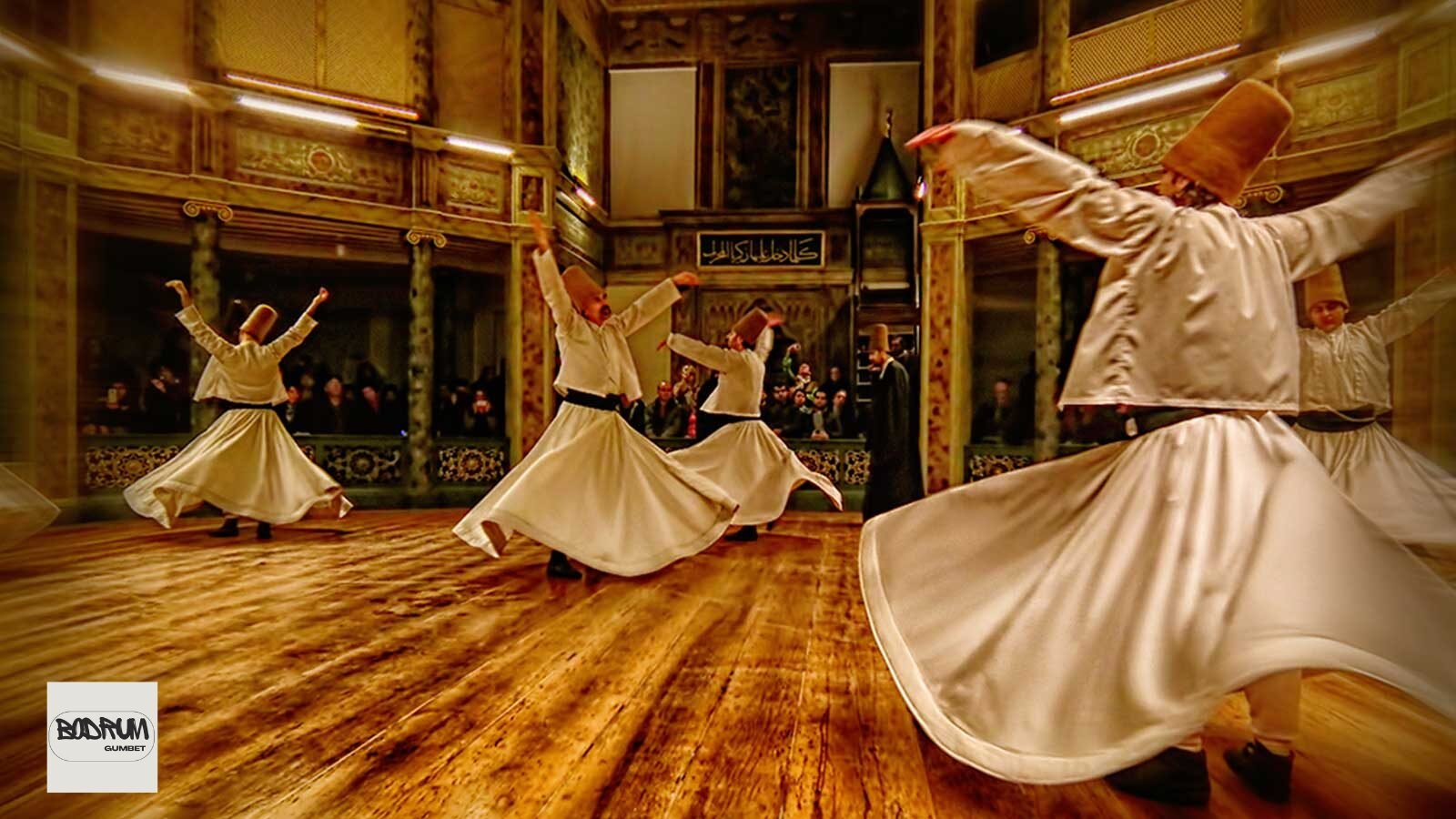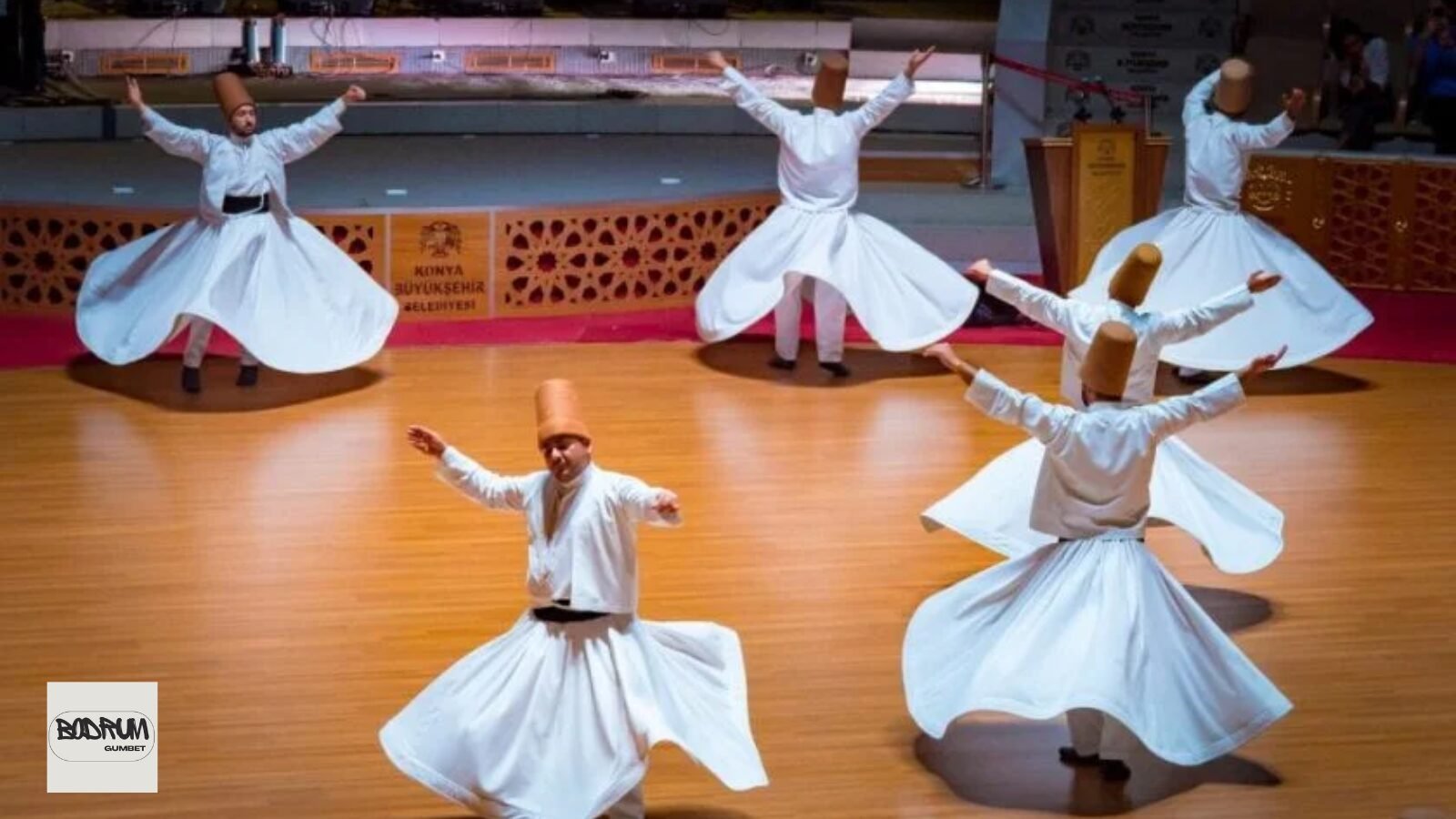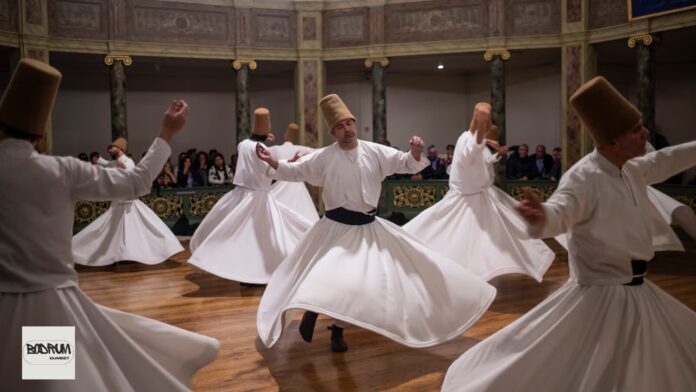Have you ever witnessed a man twirling in a big white gown with a high hat? That’s a Whirling Dervish! They are unique to Turkish culture. This blog will describe who these people are and why they perform this spectacular kind of dance.
Let’s unveil the purpose behind their spinning and find out more about this amazing custom.
Let’s get started!
Whirling Dervish Meaning & Definition: A Deep Dive?

A whirling dervish is a member of a Sufi order known as the Dervishes people who have dedicated their lives exclusively to prayers and spirituality and the reason why it is called a whirling dervish is because of the movement that the dervishes make while performing their religious rituals.
A whirling dervish is, in fact, a member of the Mevlevi Order – a fraternity connected to Rumi, a famous poet and mystic of the 13th century. The dervishes are famous for their special movements such as whirling in circles during some religious rituals. This spinning is called “Sema,” and it’s a way for them to worship God through dance.
The word ‘dervish’ itself derives from the Arabic and means a seeker or a poor person, and which signifies the fact that the dervishes themselves often leave a life of material comfort and luxury to devote themselves more wholly to the spiritual path.
Why Do They Whirl?
Among them, spinning, or whirling, symbolizes the continuous activity of the universe. It also symbolizes the odyssey of the soul towards the attainment of knowledge. When a dervish spins, he wants to touch something greater than them or be one with the universe. It is a form of worship and a show of adoration to God and all believers in existence, similar to dancing for God.
Let’s Look at History of the Whirling Dervishes
The whirling dervishes, an unconventional religious order, emerged in the 13th century. It takes root with the legendary of Jalal al-Din Rumi, the poet and the Sufi, born in the year of 1207 in Balkh, Afghanistan. Rumi left Persian in 1229 to Konya of Turkey because of the Mongol invasions. He began the Mevlevi Order of Sufi in Konya in the year of 1244.
The tradition of whirling started after Rumi had a mystical experience. According to legend, while in a marketplace, he heard the rhythmic sounds of goldsmiths hammering metal. This sound seemed to transport him into a trance. He began to spin in circles, a movement that represented the motion of the planets and stars. This spinning was meant to reflect the harmony and order of the universe. His followers, inspired by this experience, began practicing whirling as a spiritual ritual.
During the Ottoman Empire, the Mevlevi Order became widely known. The dervishes, or members of the order, were highly respected as spiritual leaders. The whirling ceremony, known as “Sema,” became a key part of their worship. In the Sema, dervishes spin while raising one hand to the sky and pointing the other hand downward. This gesture symbolizes receiving divine grace and passing it on to the world.
In the year 1926, the then Turkish government, under the presidency of Mustafa Kemal Atatürk, banned the Sufi orders as well as the Mevlevi orders. This was in line with a strategy to’modernize’’ Turkey and appear less’religious. ’ For this reason, the government considers these orders as a threat to their task of producing a secular state in the country. The criminal prosecution that took place led to the prohibition of whirling dervishes, but they continued to dance in secret.
In 1953, the government permitted the dervishes to dance here in Konya once a year only. It occurs on December 17th, the date of the death of Rumi. It is called “Şeb-i Arus” or “the Night of Union.” It follows the ceremony of Rumi’s love with the Divine. Today different people visit this ceremony in order to watch the dervishes, so people from all over the world visit it. Basically, it is an emblem for protection that indicates peace and a sense of divinity.
Today, UNESCO believes that for the promotion of the world’s culture, the whirling dervishes are essential. Their tradition is still to this date. The Mevlevi Order comes to educate people about love, humility, and the link with the divine. It is good to note that all the mentioned values are relevant to all religions. The dervishes’ practice is a cultural value, and seeing them makes us remember that we should not be divided at present time.
At present, whirling is not only a part of worship but also much more than that. It has become a performance, a sign of worship, and even a link to the past. The Mevlevi tradition is still lively, so people continue to appreciate and respect Sufism. Not only in Turkey, but people perform in other countries as well. Such a practice is perpetual conditioning for the appreciation of Rumi’s message of love and unity in generations yet to come.
The Meaning Behind the Whirling
Whirling is more than just a dance. It’s a spiritual practice that has deep meaning. When a dervish spins, their right hand points upward, symbolizing their connection to God. Their left hand points downward, representing their connection to the earth.
The spinning motion is believed to help the dervish reach a higher state of consciousness, where they feel closer to God. It’s also a way to let go of their ego and focus on love and devotion.
Whirling dervishes are fascinating people with a rich history and a beautiful tradition. Their spinning ceremonies are a reminder of the power of movement and the importance of spiritual connection.
The Women of the Mevlevi Order
The Mevlevi Order, known for its whirling dervishes, has a long and rich history. In the beginning, women played a very important part in the order, just like men. Rumi, the founder of the Mevlevi Order, had many women students. One of these women, Destina Khatun, was even made the leader of a Mevlevi lodge.
In those early days, men and women would pray and whirl together. This showed that everyone was welcome in the Sufi way of life. Later on, things changed, and men and women often had separate ceremonies. But there were still times when they would whirl together. In 1991, a leader of the Mevlevi Order, Celaleddin Bakir Çelebi, said that men and women could whirl together again. This brought back a part of the tradition that had been lost for a long time.
Today, the Mevlevi Order remembers this history. Sometimes, both men and women take part in their ceremonies. This shows that the order is keeping Rumi’s message of love and togetherness alive in a new way.
Where Can You See Whirling Dervishes
For whirling dervish performances, you can plan to visit Turkey as it is the most appropriate place to find them. Of all these places, Konya is one of the most popular places for experiencing the most genuine performances. Each year, Konya hosts the Seb-i Arus, or the night of union, recalling the death of Rumi from around the globe. This event comes when it lasts for one week, and the culminating event is on the seventh day.
Apart from Konya, you can witness the whirling dervishes in other cities such as Istanbul and Cappadocia. Many cultural institutions and historic sites are used for these events.
Is It Just Dancing?
You may not know this but whirling is sometimes considered as a form of dancing. But to the Mevlevis it is a special way which they embrace in expressing their affection towards Allah. There are some guidelines which must be obeyed, and there is a signification in everything they perform.
The dervishes have to dress up in black garments and their shoes are similar to a coffin. This means that they are distancing themselves from who they were before. When they begin dancing, they remove their black outfits and put on white ones. This means that they are beginning a new life.
In my opinion, the Mevlevis don’t want to entertain you. They want you to start making your brain work and wonder about spirituality and how are we related to God.
Where to See a Whirling Dervish Ceremony in Konya
Konya is the heart of the Mevlevi Order, and there are several important sites where you can experience the beauty of the whirling dervishes. Here are some of the top & recommended places to visit:

Mevlana Museum & Mausoleum of Rumi
The Mevlana Museum is the resting place of Rumi and one of Turkey’s most visited spiritual sites. The museum houses artifacts from Rumi’s life and teachings, and visitors can witness whirling ceremonies here during special events.
Karatay Medrese
This historical building was once a center for Islamic education and now serves as a museum. While it is not primarily known for whirling ceremonies, it is an essential part of Konya’s spiritual history.
Ince Minare Museum
The Ince Minare Museum was once a theological school and is now a museum showcasing Islamic art. Its beautiful architecture and history make it a must-see when visiting Konya.
Selimiye Mosque
Near the Mevlana Museum, Selimiye Mosque offers visitors a glimpse into the rich spiritual history of Konya. The mosque is not only a place of worship but also holds cultural significance for those following the Mevlevi tradition.
The Sema Ceremony
The Sema ceremony is a sacred ritual in Sufism, a mystical branch of Islam. It’s a symbol of spiritual growth and the search for connection with God. The ceremony dates back over 700 years and was first practiced by followers of the famous Sufi poet, Rumi.
The ceremony is carefully planned and follows a specific order. It starts with prayers, then music, and finally the iconic whirling dance. Flutes, drums, and chants play a big part in setting the tone. These sounds help the Dervishes (the performers) to focus on reaching a meditative state.
Let’s have an overview of the Sema ceremony below.
- Entering and Greeting: The Dervishes walk into the room, bow to one another, and say prayers. This shows respect and gets them ready for the spiritual journey.
- Musical Prelude: Soft, slow music starts, allowing the Dervishes to focus. The ney (a traditional flute) is usually the first sound you’ll hear. It creates a calm and peaceful atmosphere.
- The Whirling Dance: The whirling begins. Dervishes start spinning in small, slow steps. They gradually get faster. They hold their heads slightly tilted, with their eyes open but not focusing on anything specific. While whirling, their right hand faces up to receive blessings from heaven, and their left hand faces down to pass those blessings to Earth.
- The Spiritual Journey: The whirling represents a journey from the self to unity with God. As they spin, they let go of their egos and seek divine connection. The music guides their movement, and everything flows in harmony.
- Closing Prayer: After the whirling stops, the Dervishes say a final prayer to thank God for the connection they’ve felt.
Dos and Don’ts When Attending a Sema Ceremony
If you’re attending a Whirling Dervish ceremony in Turkey, here are some key things to remember:

Dos:
- Dress modestly: Since this is a religious event, it’s respectful to wear conservative clothing. Men should avoid shorts, and women should cover their shoulders and knees.
- Arrive early: These ceremonies often attract large crowds, especially in popular cities like Konya and Istanbul. Arriving early ensures you get a good seat and can soak in the atmosphere.
- Be respectful: You may be allowed to take pictures, but be sure to turn off the flash and remain quiet throughout the ceremony.
Don’ts:
- Don’t talk: The Sema ceremony is a deeply spiritual practice. Talking during the performance could ruin the experience for others.
- Don’t treat it as a show: While it may be beautiful to watch, the Sema is a sacred ritual. It’s more than just entertainment.
- Don’t leave early: Exiting in the middle of the ceremony is seen as disrespectful. Stay until the end to show your appreciation.
Final Words
I hope after reading this, you understand more about the Whirling Dervishes and their amazing tradition. Even though a lot has changed, their special dance, part of the Mevlevi Order, is still very much alive today. This tradition has turned into a popular performance that many people enjoy watching. Cities like Istanbul and Konya are famous for these incredible shows.
